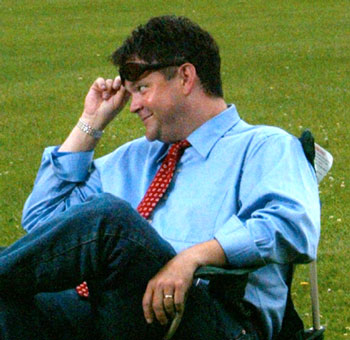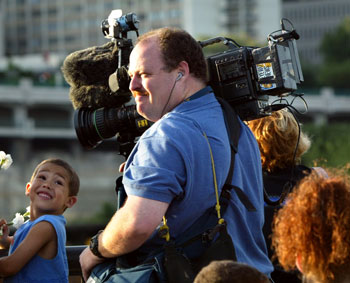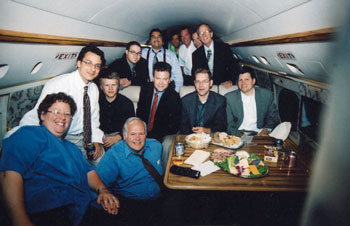 |
What Happened At KSTP That Opened The Exit Door For So Many?
Format Change, Leadership, Sale Rumors March 2004
|
||||||||||
|
What a horrible evening it was in a Houston hotel lounge October 26, 1997. A layover en route to an assignment in Oklahoma forced me and former Cleveland anchorwoman Gretchen Carlson to watch the young Florida Marlins steal Game Seven of the World Series from a seasoned Cleveland Indians team. In just four short years the Marlins had gone from an expansion club of rookies to baseball champions, the youngest team to ever win a Series. Just as Indians fans felt the agonizing taunt of ending a 40-year draught of hard luck, Marlins fans were witnessing the gutting of their team payroll by 40 percent almost immediately after the Series ended. The following season they posted an embarrassing record of 54-108.
It's been just over a year since KSTP-TV5 photojournalist John Gross eMailed me with the news that Hubbard Broadcasting was dropping KSTC's hour-long 9 p.m. newscast, eliminating 27 full- and part-time jobs in its wake. The pall cast from that announcement placed news professionals nationwide in a state of catatonia. Minneapolis is considered to be a Vatican of sorts for television photojournalism, a hallowed city where many electronic journalists in other markets covet the news of potential openings with religious fervor. The soap opera continued with what has been characterized as a revolving door of management and talent. The instability of the newsroom leadership began with the departure of news director Scott Libin at the end of the February (2003) book. Libin was held in high regard for his work at the Poynter Institute, for his integrity, and for his newsroom acumen. His replacement, Chris Berg, has been described as "a pugnacious character" by one local writer, and the professional patina of the KSTP-TV5 newsroom has been tarnished by recently reported maledictions from both him and his managing editor (who eventually resigned). Oh, yes, and let's not forget the traditional swirling rumors of a "For Sale" sign on the Hubbard doorstep. It would seem from this far away that Minneapolis -- KSTP-TV5 in particular -- has turned into a three-ring circus. Understand, however, it wasn't simply the one-time event of a major layoff or a lack of social grace that has beleaguered the staff, but also a gradual format change that affected the pace, tone, and style of KSTP-TV5's news coverage. Branding is the buzzword of the industry and it was apparent the brand change wasn't appealing to a lot of people working there.
KMSP photojournalist Cy Dodson added, "It just doesn't represent the community well. You watch the news now and you think you're living in the ghetto." Dodson was one of a number of people included in the exodus from KSTP-TV5. He wistfully recalls how exciting it was to have finally arrived in Minneapolis after working in Kentucky at WLEX: "When I got there... it was everything I thought it would be. The whole damn newscast was amazing. Getting to that second-block feature, watching Anderson, (reporter) Rod Rassman, (reporter) John Barr... The overall product was just amazing... (editor Jon) Menell was creating the news opens... Wow, this is why I came here, to be a part of that." "That" is the magic of Minneapolis television, which has an almost cultish following in the waning practice of long-format television journalism. While the rest of the country's newsrooms seem focused on keeping every story at a buck-10 or under, the Twin Cities market is one of the few markets left that still encourage fleshing out solid in-depth stories that focus on people. That, and the constant flood of awards given to stations in Denver and Minneapolis, have caused photojournalists in other markets to bristle. Perhaps out of envy, some Web site postings focused on gloating over the heavy dose of reality brought onto KSTP-TV5. "People that are not into NPPA and stuff are laughing," says KARE director of photography Brett Akagi. "(They're) saying, 'See what we deal with every day? Now you're just like us.'" Wertheimer's riposte: "Every station is a meat grinder, no matter where you go. We were able to put the right people in the right situations to achieve their creative goals. I can't blame them for looking at us that way from the outside." Sixteen-year KARE veteran Ron Stover added, "The problem for KSTP, despite the fact they had developed a great storytelling team of reporters and photographers, was their lack of long-term consistency. That has been more of a deterrent than anything else." That long-term consistency was originally the vision of then-general manager Ed Piette (now GM at WCCO), who brought Libin to the station in spring of 1998. "The station had been a little inconsistent at that time and I was Ed's first hire," says Libin. "(He) wanted me to accomplish three things: 1) restore morale and make KSTP the kind of place where people wanted to come to work; 2) repair and improve the product; and 3) make the numbers go in the right direction. He was very clear he wanted to do things in that order." Now back at Poynter as director of development and outreach, Libin clarified how he had intended to pursue the direction that would take them further up the ratings heap. "We tried to put together a newscast that would respect the audience, one that didn't fit any formula, and at the same time we didn't want to go out and imitate what KARE was doing. There was room (in Minneapolis) for another emphasis on storytelling... investigations, good storytelling, and hard news. We had a formidable competitor at WCCO, but they were going in another direction with their story count and faster pace. We were trying to occupy a position which no one had defined in that market. Neither a warm, fuzzy approach like KARE was taking, or as crime-driven or tabloid-driven as WSVN's (Miami) approach." So the dedication to quality was definitely there, mandated by the general manager. What went wrong? Libin offered this insight: "You don't have to choose between only two positions, storytelling or news of the day. Many of the skills and values that underlie long-form storytelling can work in shorter-form, general-assignment stories. It's only been within the last year or two the longer form has been edged out." "When I arrived at KSTP, we instituted Focus 5 stories six nights a week, rather than doing them only during sweeps. Consistency does not require giving extra time to stories that don't need or merit it. We continued to do long-form stories when we felt the content justified it." Libin also criticized conventional newsroom philosophies. "In this business we like clear-cut, easy answers...packages need to be 'this' long... I still think there's a lot of good photojournalism and reporting (at KSTP-TV5), but it's tougher in a shorter, high story count approach."
The St. Paul Pioneer Press published May sweeps numbers that compared 2002 to 2003. According to those numbers, KSTP-TV5 had gone from 9.2/16 to 7.9/14 at 10 p.m. Second-place WCCO boasted 12.0/21 and first-place KARE showed 14.8/26. KMSP and WFTC have 9 p.m. newscasts. In all fairness Libin countered, "May 2003 was Chris's first book at KSTP. He had instituted some changes already, but I don't think anybody reasonably expected him to have a huge impact on the numbers after only a few weeks on the job." In a December article, St. Paul Pioneer Press media critic Brian Lambert wrote about the November sweeps: "The big loser on the local scene was KSTP-TV, Channel 5. The only local late news to lose viewers from a year earlier, it dropped an entire ratings point." "Why did the improvement in photography not reflect in the ratings?" Stover ponders. "Their ratings didn't take a big surge from embracing the NPPA style of storytelling. The standard of photography in this market was already high, so it did not have a noticeable impact on the viewers. Had this been in another market, the impact would probably have been much greater." The very thought that ratings don't simply elevate when the NPPA is associated with a newsroom's visual storytelling will certainly stick in the craw of many staunch television members who believe that their interests supercede those of their stations. Protecting the sanctity of creative license to ethically tell a story is a noble and worthy goal, but television stations are businesses created to make money while serving the public interest. Many believe that television management and ownership are in cahoots to squeeze every last buck on the broken backs of employees. That idea may be in the minds of those watching this saga's continuing storyline, but I wouldn't be so quick to draw negative conclusions about Hubbard's decision-making based on second- and third-hand gossip.
It looks to me like there's still a heartbeat at KSTP-TV5, folks. For all the glum and ominous doom-saying, the numbers, attitudes, and new philosophies heaped on the news staff at KSTP-TV5, you can bet there's one person who will not be dissuaded: Mark Anderson. Imagine being chief photographer at that shop. Cy Dodson said it best when I asked him if photojournalist John Gross was one of his influences for coming to KSTP-TV5: "He was happy as hell to be there. Totally fired up about it. 'You'll be working with the best... Mark Anderson, Mark Anderson, Mark Anderson.'" There's probably no person better suited for the current times than he. You have to know Mark to appreciate his verve. As is the tradition in our friendship, eMails and voice mails are key. This is some of what he wrote to me back in November: "I got to tell you that we have our groove/momentum going with the photo staff. My new assistant chief Joe Caffrey and myself are making great strides -- having a blast and developing an even better team." "No question through adversity you have the opportunity to build some character. We're doing well. We are a work in progress. We're not perfect; perfection is not a human condition, but I can tell you we are having fun and adjusting positively as a team." "Yes, our stories are shorter, we are a live daily, hard news is the push as it should be -- but we still can enterprise stories through compelling pictures and sounds and quite frankly we're doing a great job covering the news/content of the day..." "We all know our focus is to win content and hard news of the day. My news director Chris Berg has impressive intensity and can execute a plan. More than anything else Kim, just communicating with each other with heart is making us better -- and certainly I am always trying to be the photo chief I wished I had. Joe and I share a common creed -- to treat people as you would want to be treated -- the core to developing a strong team." After that all I can do is point you south towards Florida. Marlins country. World Series Champs. Again in 2003.
© Kim Fatica, for News Photographer magazine, NPPA
|
||||||||||
|
Write a Letter to the Editor
Join our Mailing List
© The Digital Journalist
|


